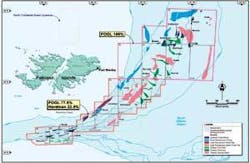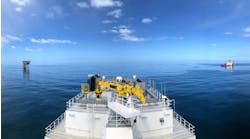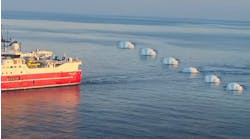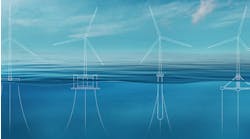Jeremy Beckman - Editor, Europe
A second wave of exploration is heading for the Falkland Islands. Five different joint ventures with licenses around the islands are looking toward the next phase of drilling. One option being considered is the formation of a drilling consortium to share a rig that could drill over 10 back-to-back wells.
Previous drilling activity in the region all was compressed into a six-month period in 1998-99. Six wells were drilled in the northern zone with mixed results, and mostly inconclusive data. More is expected from the upcoming campaign, which will extend into previously unexplored basins to the south and east of the islands.
Map shows prospects identified to date across FOGL’s two licenses south and east of the Falkland Islands.
Falkland Oil and Gas Ltd. (FOGL) believes the southeastern sector is highly prospective. Over the past three years, the company mapped 100 large to very large prospects and leads within its license areas, each with reserves potential of 200 MMboe-plus.
“Our licenses cover one of only a few large, unexplored ‘passive’ margin basins that remain in the world, and there exists very strong evidence for a working oil and gas system,” said Chief Executive Tim Bushell, commenting recently on the company’s seismic acquisition and interpretation program. “The work we have carried out to date has given evidence of mature oil-prone source rocks, quality reservoir rocks, and multiple trap types.”
The early impetus for this quest, according to Bushell, came from Hardman Resources founder Alan Burns. In the late 1990s, Burns began studying gravity maps of the Falkland Islands and identified basins in the south which he thought looked interesting. Shortly afterwards, Hardman teamed with another Australian company, Dampier Petroleum, to acquire licences south of the Falkland Islands. At that point, all the original northern zone permit holders bar Desire Petroleum had exited the islands, disillusioned by the early well results and the high exploration costs in this remote area. Bushell had worked for one of those pioneering operators, Lasmo - the others were Amerada Hess, Lundin, and Shell. “I remember the companies rushing to get hold of a seismic vessel straightaway, even though they had only just been awarded their licenses,” he says.
The mood of aggressive exploration persisted, with certain parties seemingly straining to be the first to make a discovery. One consequence was that the six wells “were not drilled in a particularly optimal way, with only two, both operated by Shell, finding hydrocarbons - one of these having tested a deeper geological setting.”
In 2002, the new joint venture - with Dampier as operator and Hardman Resources as partner - were awarded licenses south of the islands covering an area of 33,700 sq km. These were the first new awards off the islands since 1996, and also the first issued in the south. “One of the clever things Dampier and Hardman did was getting the timing right for such a large acreage award,” he says.
New seismic
During 2002-2003, Dampier acquired and processed a new 4,680 km 2D seismic survey. Interpretation of this survey led to the identification of numerous leads of varying quality in water depths from 400 to 1,850 m.
Early analysis by the joint venture indicated that the south and east Falkland basins were geologically very different from those in the north, with a much thicker sedimentary section and potentially larger hydrocarbon-bearing structures. The nearest analogy was the adjoining Malvinas basin to the west in Argentine waters, where an Exxon-operated well had flowed 3,000 b/d of oil from a poor-quality reservoir in the Cretaceous Springhill formation in 1981.
To fund the next phases of exploration, the partners agreed in 2004 to restructure the venture as Falkland Oil and Gas Ltd. (FOGL), with London-based fund manager RAB Capital brought onboard as a major shareholder. Under this arrangement, FOGL owned 75% of the license area, the remainder being held by Hardman. FOGL then raised further funds via a listing on London’s Alternative Investment Market.
Around the same time, the company launched its seismic acquisition campaign by contracting Calgary-based GSI to acquire an additional 3,500 km of 2D data over the eight most promising leads picked out by Dampier. Later that year, FOGL was awarded 100% of an adjacent 50,000 sq km permit. “License terms for the Falklands are modelled along similar lines to those in the North Sea,” Bushell points out.
Data-gathering continued through 2005, with GSI acquiring a further 9,450 km of 2D seismic across both licenses. The results were much better than expected, revealing 130 strong leads across different play types. Numerous direct hydrocarbon indicators also showed, including satellite observed oil seeps, gas chimneys, amplitude anomalies, and potential gas hydrates.
This summer, FOGL contracted Offshore Hydrocarbon Mapping in the UK to undertake a controlled source electromagnetic survey (CSEM) over the larger prospects and leads. CSEM is an emerging technique that investigates the electromagnetic properties of subsurface rocks via a dipole source towed by a boat just above the sea floor. The resultant ‘field’ is picked up by an array of remote sensing devices on the seabed. CSEM imaging works best at present in water depths of 500 m or beyond; in simple sand and shale geological sequences; and over large traps - all features prevalent in FOGL’s acreage. ‘Positive’ anomalies are indicative of the presence of hydrocarbons within the subsurface. CSEM is increasingly being used by the majors to ‘de-risk’ their prospect inventories and select the best ones for drilling.
Simultaneously, Norwegian contractor Wavefield Inseis will acquire infill 2D seismic on 10,000 km. Using the combined results of the CSEM and 2D seismic FOGL hopes to identify the most prospective targets to determine the best sites for drilling. “There will be a strong interaction between the two surveys,” Bushell says. “We will analyse and integrate the data as it comes in onboard both the OHM and Wavefield vessels in order to identify the best potential prospects for drilling.
The scale of these basins and their potential has caught the attention of some larger oil companies. “We have been discussing farm-in opportunities with a number of companies including several majors. The majors, in particular, are interested in the area but are quite risk averse, and therefore are approaching any investment decision quite cautiously.”
Lining up a rig is another issue. “The market remains overheated, because of the current emphasis on production drilling, with fewer rigs available for exploration. That’s understandable - when oil prices are high, you want to boost your production.
“For me, one way of getting hold of a rig in this area is to put together a program attractive to a drilling company. Contractors are unlikely to be interested in just two or three wells in the South Atlantic.”
However, a lengthier contract spread over a year or more would bring benefits both to the drilling contractor and to the various Falklands license joint venture groups, which could share mobilization and logistics costs. Bushell sees possibilities for up to 10 to 12 wells, split between the different Falkland operators.
Each well should take typically 30-35 days to drill, he believes. “In our case, the leads and prospects are not deep-lying, making it relatively easy to drill wells quite quickly.” He estimates $30 million/well, with a further $20 to $30 million for mobilizing a rig out of, for instance, West Africa.
“We would need a 2nd or 3rd generation semi, modified to work in up to 1,500-m water depth. In the north, though, the targets are in shallower water. While the weather is not overfriendly, it is no worse than what you might encounter West of Shetland or in the Norwegian North Sea.”
As for logistical support, “there is a perfectly good harbour in the capital, Port Stanley, which accommodated two anchorhandlers and all other logistical requirements for the first drilling campaign.”
If FOGL finds oil in commercial quantities, it probably would be developed via an FPSO offloading to a shuttle tanker. But the company thinks gas also may have been generated in its basins - the huge, banana-shaped Loligo structure in the northeast of its acreage being a prime candidate. If gas is found, the nearest practical market would be South Africa, which is looking to build regasification plants to ease its gas supply shortage.
“These are exciting times for FOGL,” says Bushell “the results of the CSEM survey next year should help point the way towards the best prospects for drilling, which will hopefully happen in 2008.”




